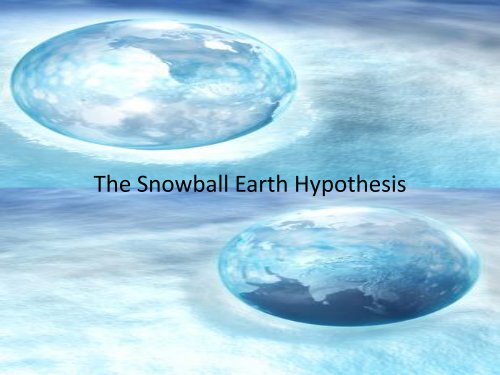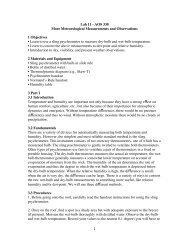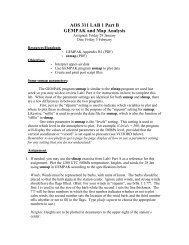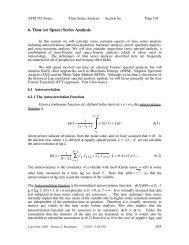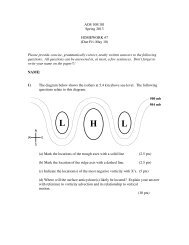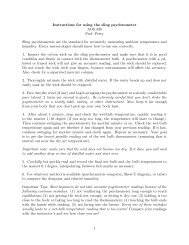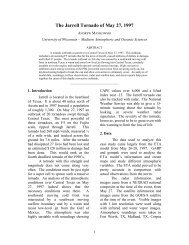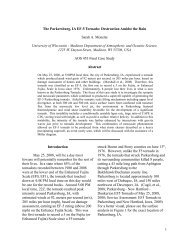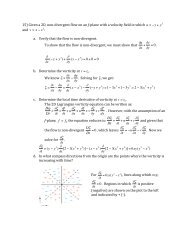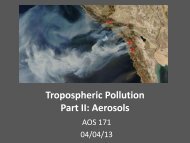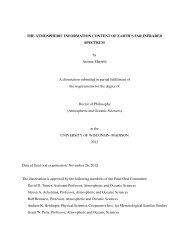The Snowball Earth Hypothesis - Atmospheric and Oceanic Sciences
The Snowball Earth Hypothesis - Atmospheric and Oceanic Sciences
The Snowball Earth Hypothesis - Atmospheric and Oceanic Sciences
You also want an ePaper? Increase the reach of your titles
YUMPU automatically turns print PDFs into web optimized ePapers that Google loves.
Neoproterozoic <strong>Snowball</strong> Era• This was a period of continental dispersion• This involved the breakup of supercontinentRodinia <strong>and</strong> the aggregation of megacontinentGodwana
<strong>The</strong>ories - Albedo FeedbackAn effect of a 30% reduction inmeridional heat transport <strong>and</strong> theestimated solar flux at ~ 600Ma
Conclusions from Paper 1• Widespread distribution of LNGD on virtuallyevery continent• Large orbital obliquity• Placing continents in tropical regions results ina colder earth by raising surface albedo <strong>and</strong>enhances silicate weathering
Paper 2: On Initiation of a <strong>Snowball</strong> <strong>Earth</strong>Solar luminosity theory• Change in solar luminosity caused totalglaciation?• Stellar evolution models suggest that theluminosity of the sun has increased by ~40%over <strong>Earth</strong>’s history <strong>and</strong> was ~7% lessluminous than today during theNeoproterozoic
However…• If this were the case why then were totalglaciations non-existent prior to theNeoprotetozoic when the sun was evendimmer?• This may be a contributing factor, but is notthe sole cause of the Neoprotetozoicglaciation
Continents near the equator theory• A concentration of l<strong>and</strong> in the tropics wouldcontribute to lower CO2 due to increasedchemical weathering rates• Increased chemical weathering rates occur inthe tropics because chemical processes areaccelerated by higher temperatures• Lower rates of CO2 in the atmosphere wouldthen lead to a gradually colder climate
<strong>The</strong>refore…• <strong>The</strong>re is more evidence for low latitudecontinental distribution during theNeoproterozoic with no evidence for largecontinental area at high latitudes than for anyother time in <strong>Earth</strong> history
Carbon Isotopes <strong>and</strong> Organic Carbon Burialin the Neoproterozoic• Both 13 C <strong>and</strong> 12 C are stable isotopes of carbonthat occur naturally in the <strong>Earth</strong>’s water, air,<strong>and</strong> vegetation• 12 C isotope accounts for more than 99% of allthe carbon present on <strong>Earth</strong>
Carbon Isotope <strong>The</strong>ory• Marine microorgansims take up carbonpreferring the lighter 12 C to the heavier 13 C• Photosynthesis causes 12 C levels in water todrop, leaving less of that isotope to precipitateout
How carbon isotopes relate to capcarbonates• Cap carbonates – sediments that weredeposited toward the end of theNeoproterozoic glaciations• Scientists found suprisingly high levels of 12 C inthese sediments• <strong>The</strong> ratio of carbon isotopes suggested thatalmost no photosynthesis had occurred in thewaters from which the rocks precipitated
No light – No photosynthesis!• This was exactly what would occur if ice hadcovered the <strong>Earth</strong> <strong>and</strong> starved it of light!
But then methane comes in…• Large amounts of organic matter would havebeen trapped under ice sheets on l<strong>and</strong> during theNeoproterozoic• Methane released when this matter decomposedwould have remained trapped in this ice• <strong>The</strong>n when the ice started to melt, ice sheets onl<strong>and</strong> close to the oceans would have beenflooded by rising sea levels <strong>and</strong> the methaneslowly released
Did this methane contain high levels of 12 C orwas it the lack of photosynthesis?• This methane that was trapped under the icewould have contained high levels of 12 C aswell• This could have caused the skewed isotoperatios seen in the cap carbonates
Paper 2 Conclusions• Changes in solar luminosity - ~7% less luminousthan today – Doesn’t completely explain the<strong>Snowball</strong> hypothesis• Continents in the tropics was a critical boundarycondition• A concentration of tropical continents may loweratmospheric CO2 by intensifying the weatheringfeedback• Effective organic carbon burial over millions ofyears may have led to the buildup of methane
Conclusions:Four proposed stages of a <strong>Snowball</strong> <strong>Earth</strong>
Conclusions…
Conclusions…
Further thoughts…• Paleomagnetic evidence of high-latitudeglaciation is lacking because there is nopaleomagnetic evidence for high-latitudecontinents in the late Neoproterozoic• <strong>The</strong> preponderance of low-latitude continentsmight be a condition for a <strong>Snowball</strong> <strong>Earth</strong>because of the increased planetary albedo• <strong>The</strong> polar oceans could have been frozen over ina <strong>Snowball</strong> <strong>Earth</strong> but would leave nopaleomagnetic record• A quick look at more current data…
Vostok delta TS4oC2HoloceneInterglacialEmianInterglacial0-2-4-6-8-10Wisconsin Ice AgeIllinois Ice Age0 50000 100000 150000 200000 250000 300000 350000 400000 450000Figure 4.2. Global temperature variations over the last four glacial / interglacial cyclesinferred from Vostok deuterium [Petit et al. 2001; data from www.ncdc.noaa.gov/paleo].
300Vostok CO 2 (ppmv)2752502252001750 5000 10000 15000 20000 25000Figure 4.4d. Variation of CO 2 (ppmv) at Vostok, Antarctica over the past 25,000 years[Petit et al. 2001; data from www.ncdc.noaa.gov/paleo].
Vostok CH47006506005505004504003503000 5000 10000 15000 20000 25000Figure 4.4e. Variation of CH 4 (ppbv) at Vostok, Antarctica over the past 25,000 years[Petit et al. 2001; data from www.ncdc.noaa.gov/paleo].
Discussion Questions• Did the ice start at the equator <strong>and</strong> move poleward orstart at the pole <strong>and</strong> move equatorward?• If all of the continents were concentrated near theequator how did the ice form at the poles?• If there was reduced chemical weathering at the polesdue to the colder, icier conditions wasn’t there ampleCO2 in the air to prevent ice from movingequatorward?• How deep/thick was this ice sheet?• What is keeping the temperature at a certainminimum <strong>and</strong> a certain maximum over the last 450,000years?
References• Schrag, Daniel P., Berner, Robert A., Hoffman Paul F., <strong>and</strong> Halverson, GalenP., On the Initiation of a <strong>Snowball</strong> <strong>Earth</strong>, Geochemistry, Geophysics, <strong>and</strong>Geosystems, Volume 3, Number 6, 27 June, 2002• Hoffman, Paul F., <strong>and</strong> Schrag, Daniel P., <strong>The</strong> <strong>Snowball</strong> <strong>Earth</strong> <strong>Hypothesis</strong>:Testing the limits of global change, Terra Nova, Vol. 14 No. 3. 129-155


